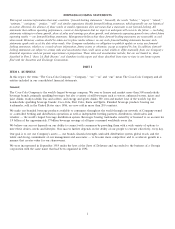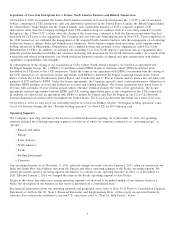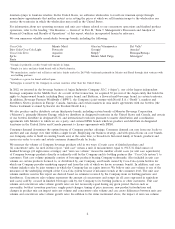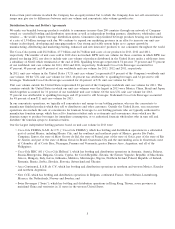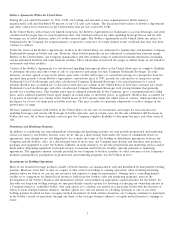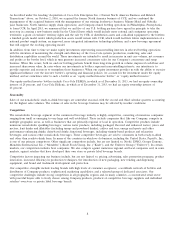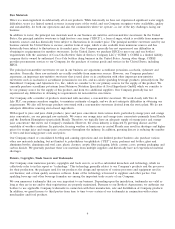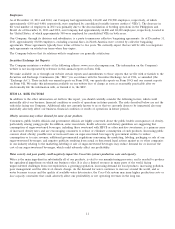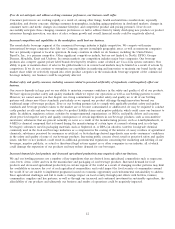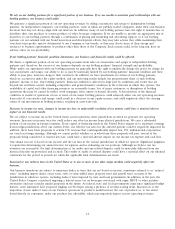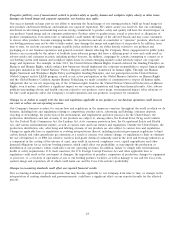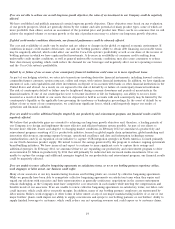Coca Cola 2013 Annual Report Download - page 11
Download and view the complete annual report
Please find page 11 of the 2013 Coca Cola annual report below. You can navigate through the pages in the report by either clicking on the pages listed below, or by using the keyword search tool below to find specific information within the annual report.Raw Materials
Water is a main ingredient in substantially all of our products. While historically we have not experienced significant water supply
difficulties, water is a limited natural resource in many parts of the world, and our Company recognizes water availability, quality
and sustainability, for both our operations and also the communities where we operate, as one of the key challenges facing our
business.
In addition to water, the principal raw materials used in our business are nutritive and non-nutritive sweeteners. In the United
States, the principal nutritive sweetener is high fructose corn syrup (‘‘HFCS’’), a form of sugar, which is available from numerous
domestic sources and has historically been subject to fluctuations in its market price. The principal nutritive sweetener used by our
business outside the United States is sucrose, another form of sugar, which is also available from numerous sources and has
historically been subject to fluctuations in its market price. Our Company generally has not experienced any difficulties in
obtaining its requirements for nutritive sweeteners. In the United States, we purchase HFCS to meet our and our bottlers’
requirements with the assistance of Coca-Cola Bottlers’ Sales & Services Company LLC (‘‘CCBSS’’). CCBSS is a limited liability
company that is owned by authorized Coca-Cola bottlers doing business in the United States. Among other things, CCBSS
provides procurement services to our Company for the purchase of various goods and services in the United States, including
HFCS.
The principal non-nutritive sweeteners we use in our business are aspartame, acesulfame potassium, saccharin, cyclamate and
sucralose. Generally, these raw materials are readily available from numerous sources. However, our Company purchases
aspartame, an important non-nutritive sweetener that is used alone or in combination with other important non-nutritive
sweeteners such as saccharin or acesulfame potassium in our low- and no-calorie sparkling beverage products, primarily from The
NutraSweet Company and Ajinomoto Co., Inc., which we consider to be our primary sources for the supply of this product. We
currently purchase acesulfame potassium from Nutrinova Nutrition Specialties & Food Ingredients GmbH, which we consider to
be our primary source for the supply of this product, and from two additional suppliers. Our Company generally has not
experienced any difficulties in obtaining its requirements for non-nutritive sweeteners.
Our Company sells a number of products sweetened with sucralose, a non-nutritive sweetener. We work closely with Tate &
Lyle PLC, our primary sucralose supplier, to maintain continuity of supply, and we do not anticipate difficulties in obtaining our
requirements. We also sell beverage products sweetened with a non-nutritive sweetener derived from the stevia plant. We do not
anticipate difficulties sourcing stevia-based ingredients.
With regard to juice and juice drink products, juice and juice concentrate from various fruits, particularly orange juice and orange
juice concentrate, are our principal raw materials. We source our orange juice and orange juice concentrate primarily from Florida
and the Southern Hemisphere (particularly Brazil). Therefore, we typically have an adequate supply of orange juice and orange
juice concentrate that meets our Company’s standards. However, the citrus industry is impacted by greening disease and the
variability of weather conditions. In particular, freezing weather or hurricanes in central Florida may result in shortages and higher
prices for orange juice and orange juice concentrate throughout the industry. In addition, greening disease is reducing the number
of trees and increasing grower costs and prices.
Our Company-owned or consolidated bottling and canning operations and our finished product business also purchase various
other raw materials including, but not limited to, polyethylene terephthalate (‘‘PET’’) resin, preforms and bottles; glass and
aluminum bottles; aluminum and steel cans; plastic closures; aseptic fiber packaging; labels; cartons; cases; postmix packaging; and
carbon dioxide. We generally purchase these raw materials from multiple suppliers and historically have not experienced material
shortages.
Patents, Copyrights, Trade Secrets and Trademarks
Our Company owns numerous patents, copyrights and trade secrets, as well as substantial know-how and technology, which we
collectively refer to in this report as ‘‘technology.’’ This technology generally relates to our Company’s products and the processes
for their production; the packages used for our products; the design and operation of various processes and equipment used in
our business; and certain quality assurance software. Some of the technology is licensed to suppliers and other parties. Our
sparkling beverage and other beverage formulae are among the important trade secrets of our Company.
We own numerous trademarks that are very important to our business. Depending upon the jurisdiction, trademarks are valid as
long as they are in use and/or their registrations are properly maintained. Pursuant to our Bottler’s Agreements, we authorize our
bottlers to use applicable Company trademarks in connection with their manufacture, sale and distribution of Company products.
In addition, we grant licenses to third parties from time to time to use certain of our trademarks in conjunction with certain
merchandise and food products.
9



